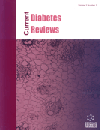
Full text loading...
We use cookies to track usage and preferences.I Understand
Type 1 diabetes mellitus (T1D) is a complicated illness marked by the death of insulin-producing pancreatic beta cells, which ultimately leads to insulin insufficiency and hyperglycemia. T lymphocytes are considered to destroy pancreatic beta cells in the etiology of T1D as a result of hereditary and environmental factors. Although the latter factors are very important causes of T1D development, this disease is very genetically predisposed, so there is a significant genetic component to T1D susceptibility. Among the T1D-associated gene mutations, those that affect genes that encode the traditional Human Leukocyte Antigens (HLA) entail the highest risk of T1D development. Accordingly, the results of decades of genetic linkage and association studies clearly demonstrate that mutations in the HLA genes are the most associated mutations with T1D. They can, therefore, be used as biomarkers for prediction strategies and may even prove to be of value for personalized treatments. Other immunity-associated genetic loci are also associated with higher T1D risk. Indeed, T1D is considered an autoimmune disease. Its prevalence is rising globally, especially among children and young people. Given the global rise of, and thus interest in, autoimmune diseases, here we present a short overview of the link between immunity, especially HLA, genes and T1D.

Article metrics loading...

Full text loading...
References


Data & Media loading...
Supplements

